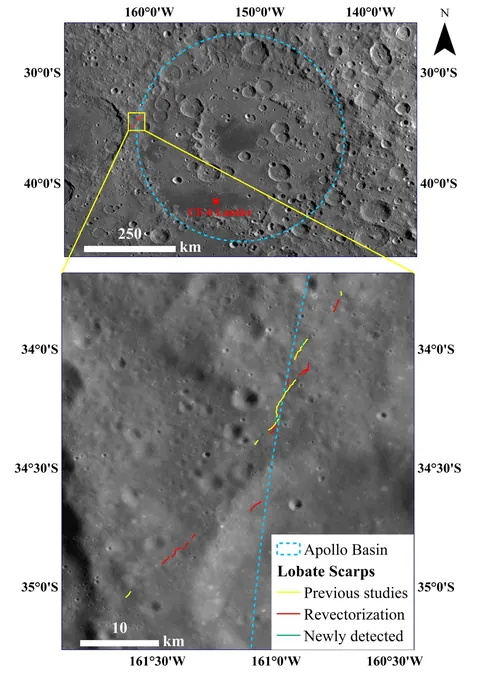
AI Technology Unveils Secrets of the Moon’s Mysterious Lobate Scarps Near Chang'e-6 Site!
2025-05-09
Author: Wei
In an exciting breakthrough, a team led by Prof. Di Kaichang from the Aerospace Information Research Institute of the Chinese Academy of Sciences is revolutionizing our understanding of the moon with cutting-edge AI technology!
This innovative research employs a generative adversarial network (GAN) to synthesize high-resolution digital elevation models (DEMs) from NASA's Lunar Reconnaissance Orbiter Camera imagery, boosting the detail to an impressive two-meter resolution.
What Are Lobate Scarps?
Lobate scarps are intriguing landforms believed to illustrate ancient tectonic activity on the lunar surface. Their detailed study provides a peek into the moon's geological past, allowing researchers to decode its evolutionary story.
Challenging Long-held Theories!
Published in the journal Icarus, this groundbreaking study takes aim at the established lunar magma ocean (LMO) model, which suggests that the moon’s surface formed from a deep magma ocean. Instead, findings advocate for the initially totally molten (ITM) model, positing that the moon was born entirely molten before solidifying and shrinking.
Fascinating New Discoveries!
Focusing on 18 distinct lobate scarps located around 300 km northwest of the Chang'e-6 landing site within the Apollo basin, researchers uncovered that these features formed under intense horizontal pressures of over 400 megapascals in the last 80 million years, showcasing a compelling narrative of a cooling moon contracting over time.
Precision Like Never Before!
The GAN-based DEM generation achieved astounding precision, boasting a root mean square error of just 0.75 meters against high-resolution DTMs. This level of accuracy allowed for unprecedented three-dimensional analysis of lunar scarps, revealing an average dip angle of 22.95 degrees, a relief of 18.7 meters, and a significant horizontal displacement of 46.5 meters.
Unique Tectonic Features!
Interestingly, the displacement-length ratio of 3.80% for these lunar scarps notably surpasses similar features found on Mars and Mercury, indicating the unique tectonic behavior of the moon.
What Does This Mean for Lunar History?
Through buffered crater counting and chronological analysis, results suggest these scarps emerged between 52.8 and 74.9 million years ago, with an estimated average age of 59.3 million years—further validating the ITM model.
This study not only questions the LMO model’s implication that large-scale volcanic activity ceased early in the moon’s history but also reveals insights from Chang'e-6 samples indicating that 2.8-billion-year-old basalts lack KREEP, a geochemical component abundant in potassium and rare earth elements.
This fresh perspective on lunar geology promises to reshape our understanding of the moon's dynamic evolution and ongoing tectonic processes, keeping astronomers and astrophysicists buzzing with excitement!

 Brasil (PT)
Brasil (PT)
 Canada (EN)
Canada (EN)
 Chile (ES)
Chile (ES)
 Česko (CS)
Česko (CS)
 대한민국 (KO)
대한민국 (KO)
 España (ES)
España (ES)
 France (FR)
France (FR)
 Hong Kong (EN)
Hong Kong (EN)
 Italia (IT)
Italia (IT)
 日本 (JA)
日本 (JA)
 Magyarország (HU)
Magyarország (HU)
 Norge (NO)
Norge (NO)
 Polska (PL)
Polska (PL)
 Schweiz (DE)
Schweiz (DE)
 Singapore (EN)
Singapore (EN)
 Sverige (SV)
Sverige (SV)
 Suomi (FI)
Suomi (FI)
 Türkiye (TR)
Türkiye (TR)
 الإمارات العربية المتحدة (AR)
الإمارات العربية المتحدة (AR)